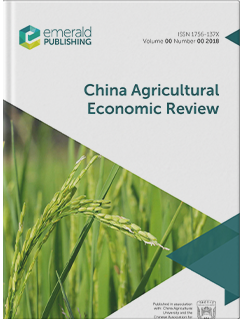Agricultural carbon footprint and food security: an assessment of multiple carbon mitigation strategies in China
IF 4.6
2区 经济学
Q1 AGRICULTURAL ECONOMICS & POLICY
引用次数: 8
Abstract
PurposeTo achieve the dual goals of decarbonization and food security, this paper examines China's carbon footprint reduction in 2050 based on current mitigation strategies.Design/methodology/approachConsidering publications as featured evidence, this study develops an investigation of agricultural decarbonization in China. First, the authors summarize the mitigation strategies for agricultural greenhouse gas (GHG) emissions in the existing literature. Second, the authors demonstrate the domestic food production target in 2050 and the projection target's projected life-cycle-based GHG emissions at the commodity level. Lastly, the authors forecast China's emission removal in the agri-food sector in 2050 concerning current mitigation strategies and commodity productions. The authors highlight the extent to which each mitigation strategy contributes to decarbonization in China.FindingsPractices promoting sustainable development in the agri-food sector significantly contribute to GHG emission removal. The authors find mitigation strategies inhibiting future GHG emissions in the agri-food sector comprise improving nitrogen use efficiency in fertilizers, changing food consumption structure, manure management, cover crops, food waste reduction, dietary change of livestock and covered manure. A 10% improvement in nitrogen use efficiency contributes to 5.03% of GHG emission removal in the agri-food sector by 2050. Reducing food waste and food processing from 30% to 20% would inhibit 1.59% of the total GHG emissions in the agri-food sector.Originality/valueThis study contributes to policy discussions by accounting for agricultural direct and indirect emission components and assessing the dynamic changes in those related components. This study also extends existing research by forecasting to which extent the decarbonization effects implemented by current mitigation strategies can be achieved while meeting 2050 food security in China.农业碳足迹与粮食安全:中国多种碳减缓战略评估
为了实现脱碳和粮食安全的双重目标,本文在现有减缓策略的基础上,对中国2050年的碳足迹减少进行了研究。设计/方法/途径考虑到出版物作为特征证据,本研究对中国农业脱碳进行了调查。首先,作者总结了现有文献中的农业温室气体(GHG)排放减缓策略。其次,作者展示了2050年国内粮食生产目标和预测目标在商品层面基于生命周期的预测温室气体排放。最后,作者根据当前的减排策略和商品生产预测了2050年中国农业食品部门的减排情况。作者强调了每种缓解策略对中国脱碳的贡献程度。促进农业食品部门可持续发展的做法对消除温室气体排放有重大贡献。作者发现,抑制农业食品部门未来温室气体排放的缓解策略包括提高肥料中的氮利用效率、改变食物消费结构、粪肥管理、覆盖作物、减少食物浪费、改变牲畜和覆盖粪肥的饮食。到2050年,氮素利用效率提高10%,将使农业食品部门的温室气体排放量减少5.03%。将食品浪费和食品加工从30%减少到20%将减少农业食品部门温室气体排放总量的1.59%。独创性/价值本研究通过计算农业直接和间接排放成分,并评估这些相关成分的动态变化,有助于政策讨论。本研究还通过预测在满足2050年中国粮食安全的情况下,当前减缓战略实施的脱碳效果能在多大程度上实现,对现有研究进行了扩展。
本文章由计算机程序翻译,如有差异,请以英文原文为准。
求助全文
约1分钟内获得全文
求助全文
来源期刊

China Agricultural Economic Review
AGRICULTURAL ECONOMICS & POLICY-
CiteScore
9.80
自引率
5.90%
发文量
41
审稿时长
>12 weeks
期刊介绍:
Published in association with China Agricultural University and the Chinese Association for Agricultural Economics, China Agricultural Economic Review publishes academic writings by international scholars, and particularly encourages empirical work that can be replicated and extended by others; and research articles that employ econometric and statistical hypothesis testing, optimization and simulation models. The journal aims to publish research which can be applied to China’s agricultural and rural policy-making process, the development of the agricultural economics discipline and to developing countries hoping to learn from China’s agricultural and rural development.
 求助内容:
求助内容: 应助结果提醒方式:
应助结果提醒方式:


